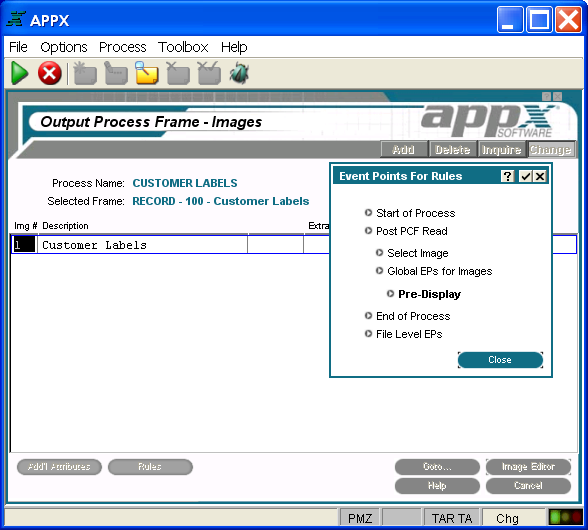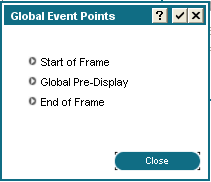Chapter 3-7: Output Processes |
Output Image Rules Option When you select the Rules option on either the Scrolling Output Images screen or the Non-Scrolling Output Images screen, the output image Event Points for Rules overlay is displayed as shown below. This overlay provides options to access the ILF Editor for APPX event points.If statements are defined in an event point, the respective text on the screen is highlighted.
Output Image Event Points for Rules Overlay The output image Event Points for Rules overlay contains the following options: Start of Process accesses the ILF editor for the Start of Process event point. Upon completion, you are returned to the Event Points overlay. Post PCF Read accesses the ILF editor for the Post PCF Read event point. Upon completion, you are returned to the Event Points overlay. Select Image accesses the ILF editor for the Select Image event point. Upon completion, you are returned to the Event Points overlay. Global EP's for Images calls the Global Event Points overlay shown below.
Global Event Points Overlay This overlay provides options for three additional event points: Start of Frame accesses the ILF editor for the Start of Frame event point. Upon completion, you are returned to the Global Event Points overlay. Global Pre-Display accesses the ILF editor for the Global Pre-Display event point. Upon completion, you are returned to the Global Event Points overlay. End of Frame accesses the ILF editor for the End of Frame event point. Upon completion, you are returned to the Global Event Points overlay.
Pre-Display accesses the ILF editor for the Pre-Display event point. Upon completion, you are returned to the Event Points overlay. End of Process accesses the ILF editor for the End of Process event point. Upon completion, you are returned to the Event Points overlay. File Level EPs provides access to the File Level Event Points for the PCF file. These event points are not directly associated with the process but with the PCF file. See the Files Rules Option for more information on using these event points. Refer to Using Event Points for more information about event points. |
Application Design Manual "Powered by Appx Software"351 ©2006 By APPX Software, Inc. All Rights Reserved |

